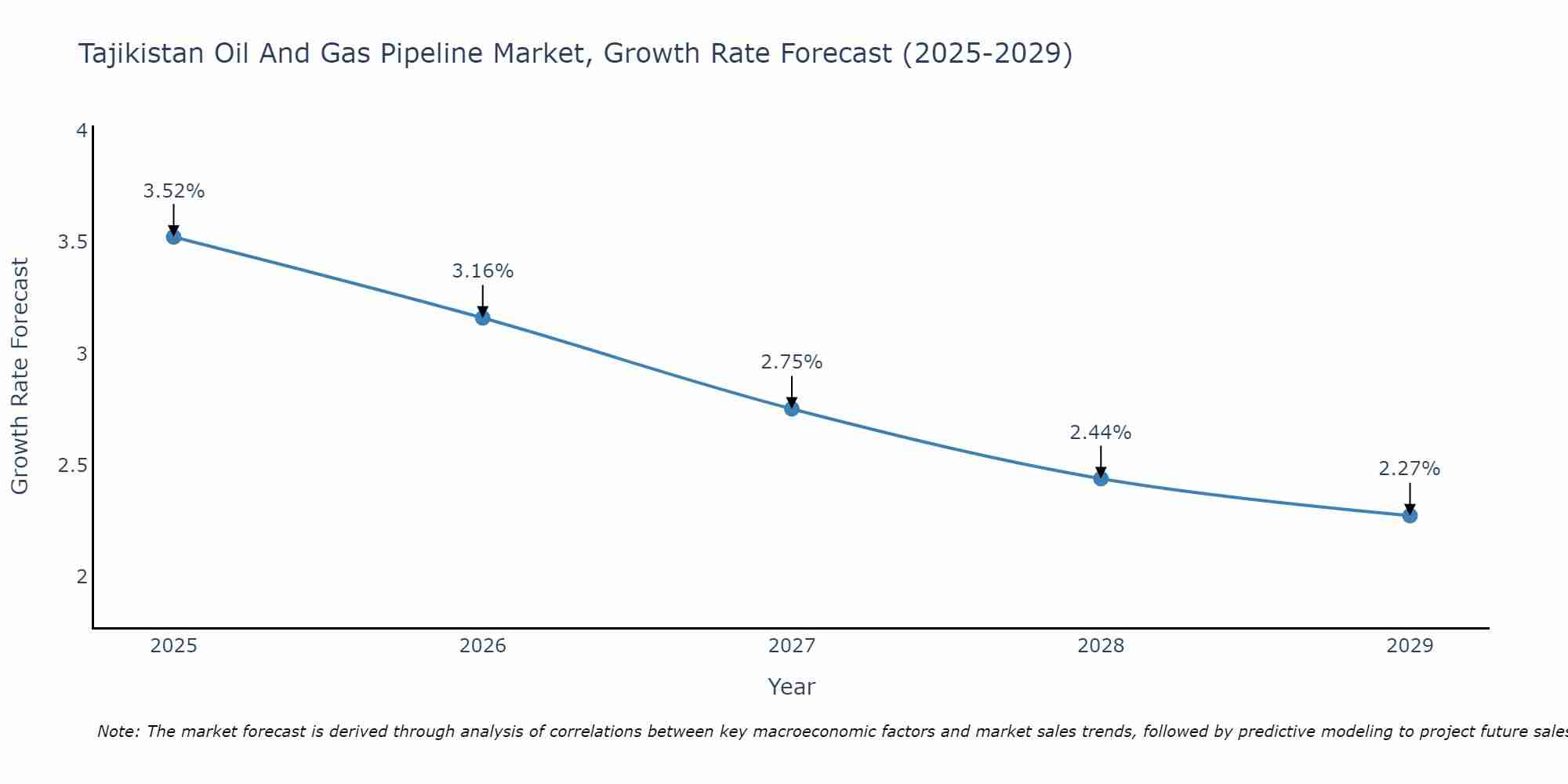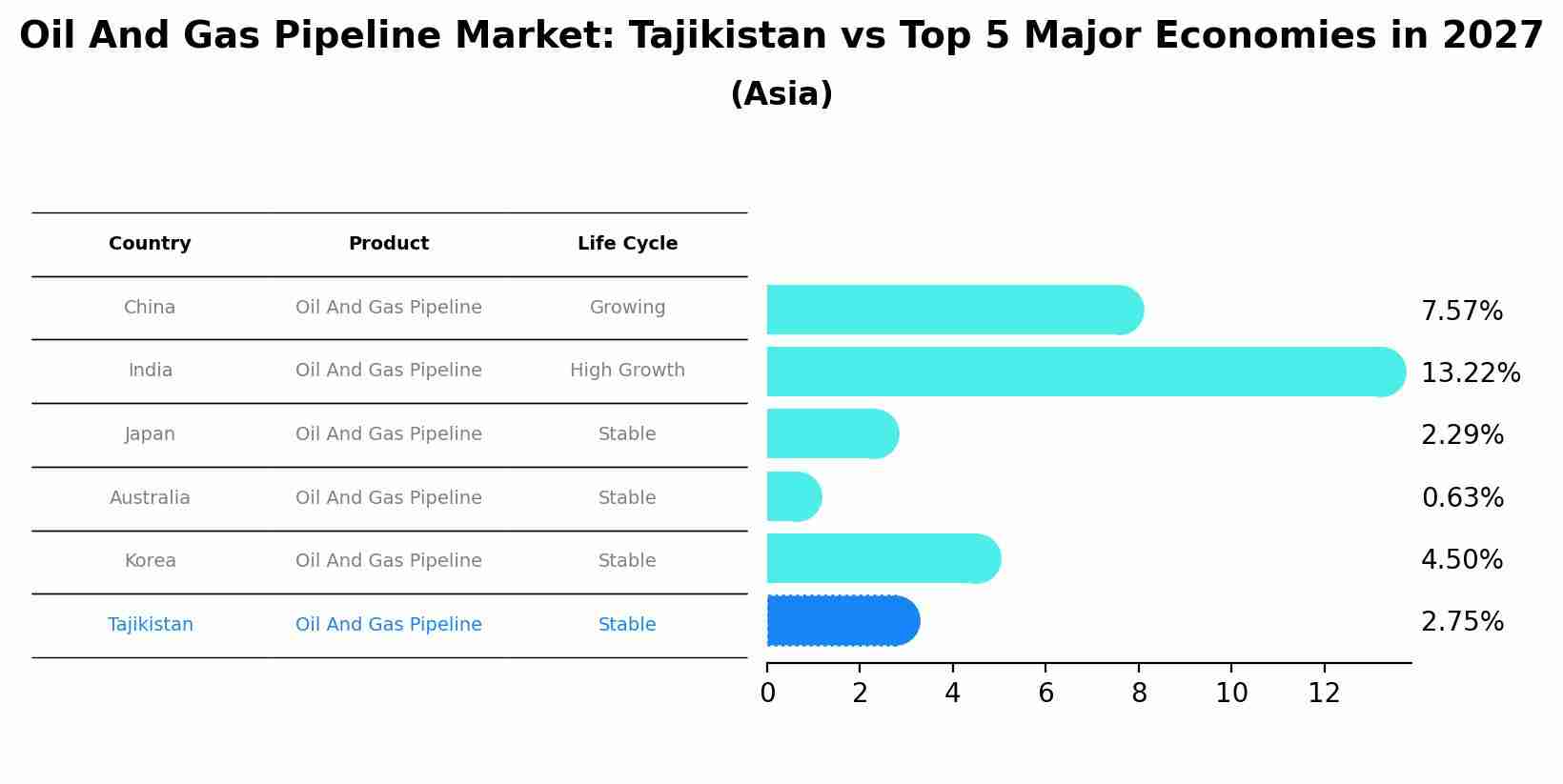Tajikistan Oil And Gas Pipeline Market (2025-2031) Outlook | Trends, Growth, Share, Size, Companies, Value, Industry, Analysis, Revenue & Forecast
| Product Code: ETC377339 | Publication Date: Aug 2022 | Updated Date: Jul 2025 | Product Type: Market Research Report | |
| Publisher: 6Wresearch | Author: Dhaval Chaurasia | No. of Pages: 75 | No. of Figures: 35 | No. of Tables: 20 |
Tajikistan Oil And Gas Pipeline Market Size Growth Rate
The Tajikistan Oil And Gas Pipeline Market may undergo a gradual slowdown in growth rates between 2025 and 2029. Although the growth rate starts strong at 3.52% in 2025, it steadily loses momentum, ending at 2.27% by 2029.

Oil And Gas Pipeline Market: Tajikistan vs Top 5 Major Economies in 2027 (Asia)
In the Asia region, the Oil And Gas Pipeline market in Tajikistan is projected to expand at a stable growth rate of 2.75% by 2027. The largest economy is China, followed by India, Japan, Australia and South Korea.

Tajikistan Oil And Gas Pipeline Market Synopsis
The Tajikistan Oil and Gas Pipeline Market is relatively underdeveloped compared to other countries in the region, with limited infrastructure and capacity. The country primarily relies on imports for its energy needs, with no significant oil or gas reserves of its own. However, recent developments in the Central Asian region, such as the construction of the TAPI (Turkmenistan-Afghanistan-Pakistan-India) pipeline, have sparked interest in Tajikistan as a potential transit country for energy resources. Tajikistan`s strategic location makes it a potential hub for energy transportation between Central and South Asia, attracting investments for the development of its pipeline infrastructure. Despite challenges such as political instability and funding constraints, the Tajikistan Oil and Gas Pipeline Market shows promise for growth and expansion in the coming years.
Tajikistan Oil And Gas Pipeline Market Trends
The Tajikistan Oil and Gas Pipeline market is witnessing a growing trend towards the development of new infrastructure to enhance the country`s energy security and facilitate the transportation of oil and gas resources. The government of Tajikistan is actively promoting investments in pipeline projects to support the expansion of its energy sector and reduce dependency on imported fuels. Additionally, there is a focus on improving the efficiency and reliability of existing pipelines through maintenance and upgrades. The market is also seeing increasing collaboration between Tajikistan and neighboring countries to establish cross-border pipelines for better connectivity and regional energy cooperation. Overall, the Tajikistan Oil and Gas Pipeline market is poised for growth with a strong emphasis on modernization and expansion efforts.
Tajikistan Oil And Gas Pipeline Market Challenges
In the Tajikistan Oil and Gas Pipeline Market, some significant challenges include political instability, lack of investment in infrastructure, geographical constraints, and regional conflicts. Political instability can lead to uncertainty in regulations and government policies, deterring potential investors. The country`s mountainous terrain presents logistical challenges in constructing and maintaining pipelines, leading to increased costs and operational difficulties. Furthermore, the region`s proximity to conflict-prone areas can pose security risks that may disrupt operations and deter foreign investment. Additionally, the lack of modern infrastructure and outdated technology hinders the efficient transportation of oil and gas, limiting the market`s growth potential. Addressing these challenges will be crucial in unlocking the full potential of the Tajikistan Oil and Gas Pipeline Market.
Tajikistan Oil And Gas Pipeline Market Investment Opportunities
The Tajikistan Oil and Gas Pipeline Market presents promising investment opportunities due to the country`s strategic geographic location and its increasing energy demands. With Tajikistan`s efforts to enhance its energy infrastructure, there is a growing need for the expansion and modernization of oil and gas pipelines to facilitate the transportation of resources within and beyond the region. Investors can explore opportunities in pipeline construction, maintenance services, technology upgrades, and project financing. Additionally, partnerships with international energy companies and government initiatives to attract foreign investment can provide avenues for profitable ventures in the Tajikistan Oil and Gas Pipeline Market. However, potential investors should conduct thorough market research, assess regulatory frameworks, and consider geopolitical risks before committing to investments in this sector.
Jordan Agar Market Government Policies
The government of Tajikistan has been actively working to attract foreign investment in the oil and gas sector, particularly in the development of pipelines to transport oil and gas resources. The Tajikistan Oil and Gas Policy focuses on increasing energy security, promoting sustainable development, and enhancing regional cooperation through the construction of pipelines. The government has implemented various policies to streamline the regulatory framework, facilitate licensing procedures, and incentivize private sector participation in pipeline projects. Additionally, Tajikistan has been engaging in partnerships with neighboring countries to expand its pipeline network and strengthen energy infrastructure, aiming to leverage its strategic location as a transit hub for oil and gas transportation in the region.
Tajikistan Oil And Gas Pipeline Market Future Outlook
The future outlook for the Tajikistan Oil and Gas Pipeline Market is poised for steady growth driven by increasing energy demand in the region. The country`s strategic location as a transit hub for Central Asian energy resources and its efforts to enhance cross-border energy connectivity will attract investment in pipeline infrastructure. Additionally, ongoing geopolitical developments, such as partnerships with neighboring countries and international organizations, will further stimulate market growth. However, challenges such as political instability, regulatory uncertainties, and competition from alternative energy sources could impact the market dynamics. Overall, the Tajikistan Oil and Gas Pipeline Market is expected to expand, driven by energy demand, infrastructure development, and strategic collaborations, presenting opportunities for industry players in the coming years.
Key Highlights of the Report:
- Tajikistan Oil And Gas Pipeline Market Outlook
- Market Size of Tajikistan Oil And Gas Pipeline Market, 2024
- Forecast of Tajikistan Oil And Gas Pipeline Market, 2031
- Historical Data and Forecast of Tajikistan Oil And Gas Pipeline Revenues & Volume for the Period 2021 - 2031
- Tajikistan Oil And Gas Pipeline Market Trend Evolution
- Tajikistan Oil And Gas Pipeline Market Drivers and Challenges
- Tajikistan Oil And Gas Pipeline Price Trends
- Tajikistan Oil And Gas Pipeline Porter's Five Forces
- Tajikistan Oil And Gas Pipeline Industry Life Cycle
- Historical Data and Forecast of Tajikistan Oil And Gas Pipeline Market Revenues & Volume By Location of Deployment for the Period 2021 - 2031
- Historical Data and Forecast of Tajikistan Oil And Gas Pipeline Market Revenues & Volume By Onshore for the Period 2021 - 2031
- Historical Data and Forecast of Tajikistan Oil And Gas Pipeline Market Revenues & Volume By Offshore for the Period 2021 - 2031
- Historical Data and Forecast of Tajikistan Oil And Gas Pipeline Market Revenues & Volume By Type for the Period 2021 - 2031
- Historical Data and Forecast of Tajikistan Oil And Gas Pipeline Market Revenues & Volume By Crude Oil Pipeline for the Period 2021 - 2031
- Historical Data and Forecast of Tajikistan Oil And Gas Pipeline Market Revenues & Volume By Gas Pipeline for the Period 2021 - 2031
- Tajikistan Oil And Gas Pipeline Import Export Trade Statistics
- Market Opportunity Assessment By Location of Deployment
- Market Opportunity Assessment By Type
- Tajikistan Oil And Gas Pipeline Top Companies Market Share
- Tajikistan Oil And Gas Pipeline Competitive Benchmarking By Technical and Operational Parameters
- Tajikistan Oil And Gas Pipeline Company Profiles
- Tajikistan Oil And Gas Pipeline Key Strategic Recommendations
Frequently Asked Questions About the Market Study (FAQs):
- Single User License$ 1,995
- Department License$ 2,400
- Site License$ 3,120
- Global License$ 3,795
Search
Thought Leadership and Analyst Meet
Our Clients
Related Reports
- Canada Oil and Gas Market (2026-2032) | Share, Segmentation, Value, Industry, Trends, Forecast, Analysis, Size & Revenue, Growth, Competitive Landscape, Outlook, Companies
- Germany Breakfast Food Market (2026-2032) | Industry, Share, Growth, Size, Companies, Value, Analysis, Revenue, Trends, Forecast & Outlook
- Australia Briquette Market (2025-2031) | Growth, Size, Revenue, Forecast, Analysis, Trends, Value, Share, Industry & Companies
- Vietnam System Integrator Market (2025-2031) | Size, Companies, Analysis, Industry, Value, Forecast, Growth, Trends, Revenue & Share
- ASEAN and Thailand Brain Health Supplements Market (2025-2031) | Strategy, Consumer Insights, Analysis, Investment Trends, Opportunities, Growth, Size, Share, Industry, Revenue, Segments, Value, Segmentation, Supply, Forecast, Restraints, Outlook, Competition, Drivers, Trends, Demand, Pricing Analysis, Competitive, Strategic Insights, Companies, Challenges
- ASEAN Bearings Market (2025-2031) | Strategy, Consumer Insights, Analysis, Investment Trends, Opportunities, Growth, Size, Share, Industry, Revenue, Segments, Value, Segmentation, Supply, Forecast, Restraints, Outlook, Competition, Drivers, Trends, Demand, Pricing Analysis, Competitive, Strategic Insights, Companies, Challenges
- Europe Flooring Market (2025-2031) | Outlook, Share, Industry, Trends, Forecast, Companies, Revenue, Size, Analysis, Growth & Value
- Saudi Arabia Manlift Market (2025-2031) | Outlook, Size, Growth, Trends, Companies, Industry, Revenue, Value, Share, Forecast & Analysis
- Uganda Excavator, Crane, and Wheel Loaders Market (2025-2031) | Strategy, Consumer Insights, Analysis, Investment Trends, Opportunities, Growth, Size, Share, Industry, Revenue, Segments, Value, Segmentation, Supply, Forecast, Restraints, Outlook, Competition, Drivers, Trends, Demand, Pricing Analysis, Competitive, Strategic Insights, Companies, Challenges
- Rwanda Excavator, Crane, and Wheel Loaders Market (2025-2031) | Strategy, Consumer Insights, Analysis, Investment Trends, Opportunities, Growth, Size, Share, Industry, Revenue, Segments, Value, Segmentation, Supply, Forecast, Restraints, Outlook, Competition, Drivers, Trends, Demand, Pricing Analysis, Competitive, Strategic Insights, Companies, Challenges
Industry Events and Analyst Meet
Whitepaper
- Middle East & Africa Commercial Security Market Click here to view more.
- Middle East & Africa Fire Safety Systems & Equipment Market Click here to view more.
- GCC Drone Market Click here to view more.
- Middle East Lighting Fixture Market Click here to view more.
- GCC Physical & Perimeter Security Market Click here to view more.
6WResearch In News
- Doha a strategic location for EV manufacturing hub: IPA Qatar
- Demand for luxury TVs surging in the GCC, says Samsung
- Empowering Growth: The Thriving Journey of Bangladesh’s Cable Industry
- Demand for luxury TVs surging in the GCC, says Samsung
- Video call with a traditional healer? Once unthinkable, it’s now common in South Africa
- Intelligent Buildings To Smooth GCC’s Path To Net Zero


















